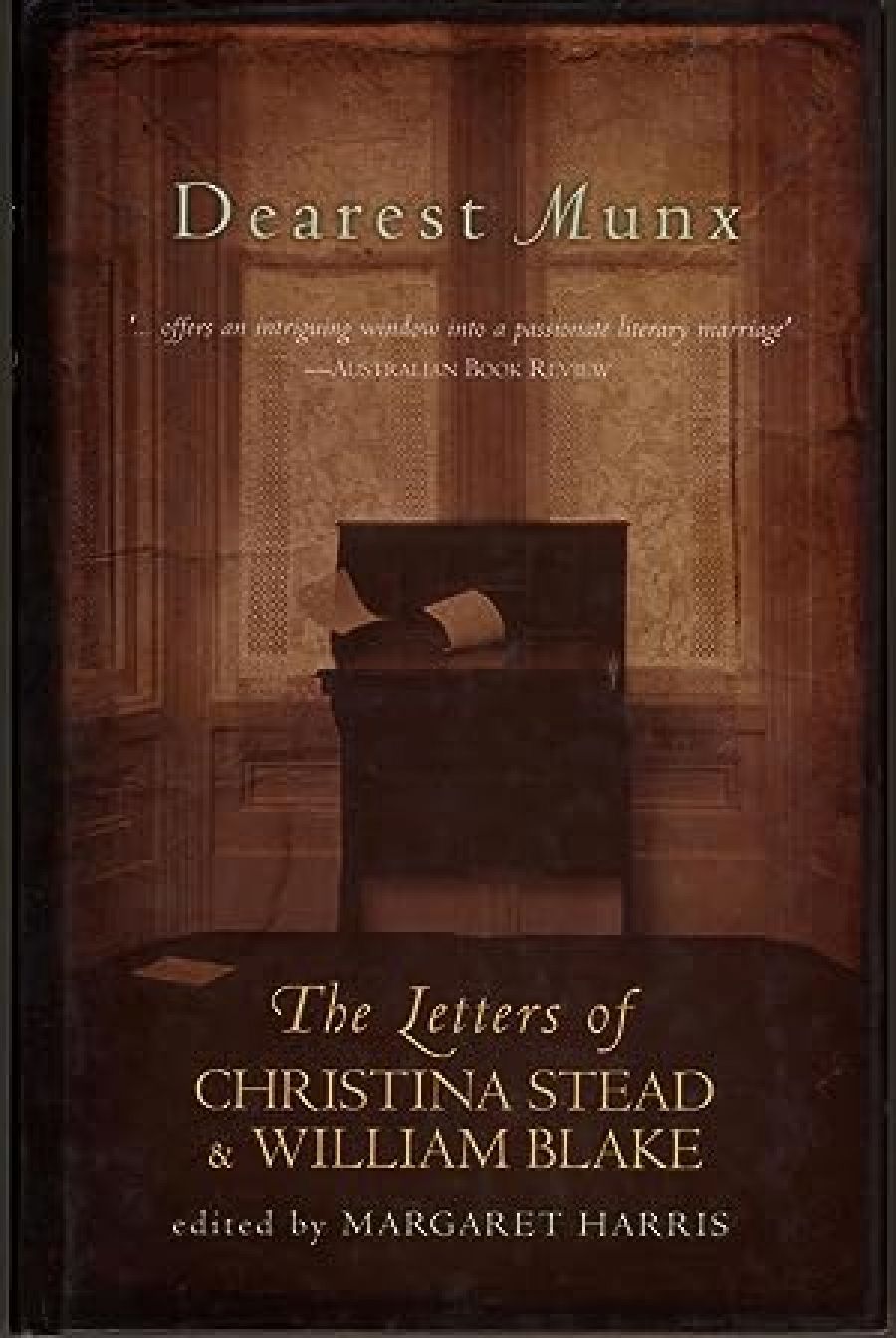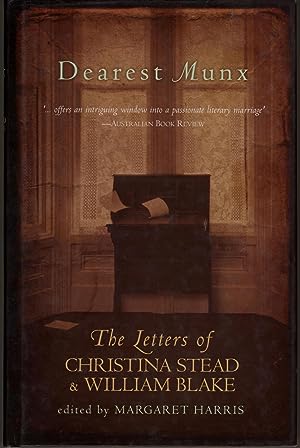
- Free Article: No
- Contents Category: Letter Collections
- Review Article: Yes
- Article Title: A true correspondence
- Online Only: No
- Custom Highlight Text:
This edition of Christina Stead’s letters to her lifelong partner, William J. Blake, offers an intriguing window into a passionate literary marriage. It also provides a welcome addition to Stead studies. Readers do not often have access to the personal letters of a great writer, let alone access to such a rich correspondence between a writer and his or her partner. As Stead’s partner was also a writer, this correspondence is peculiarly and delightfully literary.
- Book 1 Title: Dearest Munx
- Book 1 Subtitle: The Letters of Christina Stead and William J. Blake
- Book 1 Biblio: Miegunyah Press, $54.95 hb, 574 pp
- Book 1 Cover Small (400 x 600):

One of the most interesting features of the correspondence derives from the fact that Stead and Blake were frequently separated, or on the move. They spent their adult lives on the move. They lived in a series of hotels, rented flats and borrowed houses in London, Paris, New York, Hollywood, Montreal, The Hague, Antwerp, Brussels, Montreux and other places. The letters presented in this collection are grouped chronologically in sets that demonstrate the constant upheaval of moving and the disruption caused by not being together. Fortunately, Harris includes a detailed chronology of the two writers’ lives to make this narrative of relocation clear. The fact that Stead and Blake never established a permanent base or home meant that they lived as true internationalists with a genuine interest in the future of the world and a profound understanding of British, French, and American political culture. All of this is evident in these letters. But it also meant that their lives were fractured, difficult and lonely.
In fact, the constant moving around is related to another disturbing theme in the letters: poverty. When Stead and Blake first met in London in 1928, the American, Wilhelm Blech (as he was at that time until he Anglicised his name in 1936) worked at Strauss and Co., a grain exchange run by Alf Hurst, a man who is frequently mentioned in the letters (with several nicknames) and who provided the model for various characters in Stead’s novels. In 1929 Stead and Blake moved to Paris in order to work at the Travelers’ Bank, but when the Bank collapsed in 1935 the fear that Bill might have faced prosecution forced them to flee to the US.
Although from time to time Bill worked in business, he dedicated himself to writing. This meant that, after the early years in Paris when the Bank employed both Stead and Blake, money was always an issue. When Bill moved to Hollywood in 1942 in the hope of securing a contract in the film world, Stead, back in New York, prepared to sublet their rented apartment in East Sixteenth Street, before setting off on the four-day train journey to California to join Bill. Stead writes anxiously to Bill about the expense of purchasing a bedspread and a new pillow in order to make the place attractive to potential tenants, explaining how she will avoid having to ‘cover the dirty old chair … I am trying to arrange some armrests which will cover the moth-eaten patches …’. Bill explains in a letter to Christina that ‘paupers’ cannot afford to buy all their furniture again should they return to New York after a stint in Hollywood (they would instead move it to California if they decide to stay; this would cost $200, much less than the cost of replacing it) and that therefore she must sublet. He replies to her letter: ‘I would not invest in covers, etc, unless you get sales resistance to sublets. Most subletters bring some linen, etc. So if you can get away with it let them die in our schmutz.’
Such missives from Bill are accompanied with sharp, comic vignettes. He reports to Christina in the same letter:
During the weekend I wasted a bit of time going to a large gathering addressed by Charlie Chaplin, Claud Rains, Jules Garfield, Pat O’Brien, etc. all of them timides, shlemihls: funny to see the Universal idols try to say something unrehearsed – any high school kids are ten times as able … I talked to a man who was pleasant but fearfully earnest and later discovered it was Groucho! … they are … dopes, these best stipended people in the world for they are: no class of people that do not own the means of production are allowed to play with as much on a per annum basis.
Blake himself was regarded as a superbly entertaining speaker; he was frequently invited to address Communist Party events. His textbook on Marxist economic theory, published in 1939, received high praise.
The letters of both of these authors have an academic quality about them that reveals a great deal about their mutual interests, their erudition and their determination to impress one another, especially in the earlier years. Their friends come to life on the page. Fortunately, Harris provides clear and illuminating footnotes and comprehensive dramatis personae to guide the reader. In spite of the fact that they wrote long letters to one another, in many of them there is a degree of emotional understatement, reflecting a degree of stoicism and restraint on Stead’s part and idealism on Blake’s. There is poignancy also when Stead writes briefly to Bill about miscarrying shortly after he has left New York for the West Coast; she says: ‘Our varmint: the creature departed next day and was about 1 mth … It seemed a pity, why did it have to? This is what I thought for a moment: it would have been so much hope and joy for us …’
Harris also offers a commentary on the letters throughout this volume, stating plainly towards the end that Stead was ‘in denial’ about Bill’s poor health in 1967, and that she ‘is simply unable to recognise how ill he is’. Harris points to a pattern in Stead’s life, noting that immediately before Bill died the ‘act of writing to him seems to remind Christina of what he means to her, leading to a growing realisation that this time he may not be coming home’. Clearly, much of the significant communication in this relationship took place in writing. In addition to the contextual notes, Harris also manages to weave into her commentary a defence of Stead’s writing from charges of formlessness. All of this contributes to making the book a valuable resource for reading and rereading Stead’s magnificent fiction.


Comments powered by CComment